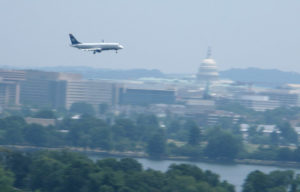 A Continental flight departing Reagan National Airport made an emergency landing at Dulles after the pilot reported hitting birds on takeoff this morning.
A Continental flight departing Reagan National Airport made an emergency landing at Dulles after the pilot reported hitting birds on takeoff this morning.
According to a recording of air traffic control radio, the pilot of the 737 reported a left engine failure as a result of the bird strike. The plane landed safely at Dulles just before 8:00 a.m.
The bird strike caused a bit of a scare on the ground. D.C. Fire and EMS crews near the Potomac River were put on alert after reports came in of an aircraft in distress. The situation recalled the 2009 “Miracle on the Hudson” — when pilot Chesley “Sully” Sullenberger landed a US Airways jet on the Hudson River after both engines were disabled by a flock of birds.
Bird strikes are actually not uncommon at Reagan National.
Despite the use of systems designed to scare birds away from the runways and alert air traffic controllers to their presence, a total of 24 bird-related incidents were reported at Reagan National last year, according to an FAA database. Of those incidents, 21 were reported as birds striking an aircraft and 3 were birds simply found injured on or near runways. Five incidents involved large birds, which are more likely to cause damage to an aircraft fuselage or engine.
Among the incidents:
- On May 1, 2010, a US Airways 737 ingested a large vulture into its #1 engine on approach. No damage was reported and the plane landed safely.
- On July 28, a United Airlines Airbus 319 struck a large bird on takeoff. The flight continued on to Chicago, where bird remains were then cleaned off the plane’s nose. No damage was reported.
- On August 8, a regional jet struck a large osprey on takeoff. Minor damage to the landing gear door was reported, but the plane continued on to Albany, N.Y.
- On October 7, an injured bald eagle was found near a runway. Crews retrieved the bird and brought it to an animal hospital. No bird strike was reported.
Although a “double bird strike” like the one that brought down Sullenberger’s plane is exceedingly rare, it is certainly not out of the realm of possibility for any aircraft, including at Reagan National.
Although airline officials and aviation regulators don’t like discussing the possibility, one pilot we spoke to said that should an airliner lose all power on takeoff from DCA as a result of bird strikes, the pilot may look for a clear stretch of river or a wide-open field — like a golf course — in which to attempt a crash landing.

